
Im Februar und März 2019 wurden von Jan-Peter Kasper aus dem Fotozentrum der Friedrich-Schiller-Universität Jena Themenbilder zur Bioinformatik erstellt. Hier sind einige Bilder zu sehen:
1. Pentagon molecule model and protractor
Many biomolecules such as nicotine, proline or ribose involve rings or, from a mathematical point of view, polygons. For their biological function it is important whether these rings are planar or folded. A rough estimate about this can be made by comparing the sum, of bond angles with the angle sum in the planar polygon.
2. Number of potential fatty acids as a function of their length
It is a question of biological interest how the number of potential fatty acids increases with their length. There is one fatty acid molecule each that only involves one or two carbons. With three carbons, there are 2, then 3, 5, 8, 13 etc. That is the famous Fibonacci series. The ratio of two consecutive numbers converges to the Golden ratio.
3. Playing pieces and dice
The playing pieces of different colours stand for the four nucleotides A, T, G and C and the double chain, for a DNA double helix. It can be calculated with which probability certain triplets, e.g. stop codons, occur in random sequences (generated by throwing the dice) depending on their distance and this can be compared to the frequency in real sequences.
4. Dynamic Optimization
The variety of metabolic pathways enables an organism to convert substrates into energy and chemical building blocks. By the application of dynamic optimization one can investigate how metabolic pathways are optimally regulated to quickly adapt to environmental changes.
5. Fibonacci numbers and Golden Ratio
The scales on pine cones are arranged in impressive spirals. Both right-handed and left-handed spirals can be observed. While the numbers of spiral arms in these two types differ, both are Fibonacci numbers (8 and 13 on the photograph). This nearly realizes the Golden Ratio with respect to the angle. Structures corresponding to the Fibonacci numbers also occur in protein and lipid molecules.
6. Payoff matrix of the interaction of pathogenic micro-organisms and immune cells
Nicht alle Krankheitserreger werden von Immunzellen bekämpft, nämlich, wenn sie sich relativ friedlich verhalten und ihre Eliminierung zu viel Aufwand erfordern würde. Solche Situationen können mittels Spieltheorie beschrieben werden, wobei jede Seite zwei Strategien hat: zu attackieren oder sich zurückzuhalten. In Auszahlungsmatrizen können die stabilen Gleichgewichte des "Spiels" ermittelt werden.
7. Understanding DNA segregation control mechanism through mathematical modeling and simulation
Correct DNA segregation is a fundamental process that ensures the faithful inheritance of genomic information for the propagation of cell life. Segregation failures underlie many human health problems, most notably aneuploidy and cancer. In this work, we benefited from computational modeling and simulation approaches embedded in a cross-disciplinary framework, typically referred to as systems biology, in order to contribute to a deeper understanding of DNA segregation mechanisms.
8. Mit den Robotern der Marke Thymio können in Lehrveranstaltungen Experimente zur Spieltheorie durchgeführt werden. Fahren zwei Roboter genau aufeinander zu, nehmen sie mittels Sensoren den jeweils anderen wahr. Sie probieren abwechslend, links oder rechts auszuweichen und "einigen" sich nach einigen Versuchen auf eine der beiden Seiten, wie man das auch von Fußgängern kennt. Spieltheorisch handelt es sich dabei um ein Koordinierungsspiel. Dies wird in der lebenden Natur z.B. beobachtet, wenn zwei Tierpopulationen sich "einigen", welches von zwei Biotopen sie bewohnen.
9. Important characteristics of pathogenic fungi and bacteria are their flexible metabolismus and the many pathways for the synthesis of secondary metabolites. With computational approaches these complex networks are analyzed and subsequently, the discovery of new antibiotics is supported.

